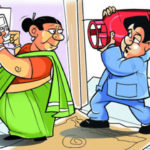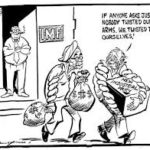In 1970s, an officer working for an oil company was the most sought after groom, a prized catch, somebody who could be panacea for all the ills afflicting the family for he could get the most coveted asset in those days, an LPG connection. In the matrimonial market his was the most sought after profile. Probably this was one of reasons why my father was so popular amongst his family members for he could get the coveted LPG connection a dream of every middle class family.
LPG was not the only commodity which a middle class home aspired for. There were other luxurious items as well. The list could be shocking for some. These were Telephones, Televisions, Music Systems, Refrigerators, Air coolers. Yes, air Coolers!! not Air conditioners, they didn’t exist even if they did it was only in top corporate offices of Delhi and Mumbai. Mobile phones were a figment of imagination which were still in the realms of obscurity.
Landline phones were considered a luxury which only rich or upper middle class could afford. We booked our landline phone in the year 1983 and it was finally installed much to our delight in 1993 and that was made possible only because one of our acquaintances got posted in MTNL as General Manager. Waiting time to get a Bajaj scooter was nine years. For millennials who can get a new telephone connection at the click of a mouse, a new bike over the counter and a Gas connection means opening a valve it might sound a bit untrue but such was the era of License and Permit Raj where in everything was controlled by Government.
Our GDP growth rate was also known as Hindu rate of growth which was between 3-4% and everything was Government controlled. In 1991 our gross fiscal deficit rose to 8.4% of the GDP and India had only USD 1.2 Billion dollars in its reserves which was barely enough to meet the essential imports for three weeks. The World Bank and IMF also stopped their assistance, leaving the government with no option except mortgaging the country’s gold to avoid defaulting on payments.
This led the Indian government to airlift national gold reserves as a pledge to a large conditional bail out from the International Monetary Fund (IMF) and World Bank in exchange for a loan to cover balance of payment debts. But the scenario changed drastically after that. In 1991 PV Narashima Rao Government took over the reins of the country and he roped in Manmohan Singh as the finance minister. Indian Government was offered loan by IMF on new terms which meant India had to reduce its import duties, reduce red tape and improve the industrial policy. The acronym LPG acquired an entirely different connotation. LPG now meant Liberalization, Privatization and Globalization.
Indian economy was thrown open to foreign companies to set up their shops and sell their merchandize in the country. Even though the policy faced a lot of criticism from our intelligentsia and intellectuals but in the hindsight it was the best thing to have happened to India and consumer were spoiled for choices.
All sectors benefitted from this LPG policy of the Government. It ushered an era of consumerism and there was a complete change in situation, earlier Consumers queued up to buy products now it was companies which were queuing up to the get the share of consumer’s wallet. Retail shifted from kiryana to modern retail, a new telephone connection could be bought in a matter of minutes and buying a motorcycle was as easy as buying a kilo of rice.
All sectors witnessed sea change and Oil Sector was no different. Oil & Gas sector was dominated by Public Sector companies and they had their monopoly in Production, refining and retailing. Till 1990s it was believed that refinery can only be built by public sector organization and only EIL has the technical expertise to build a refinery but this myth was also broken after the commissioning of Reliance Jam Nagar refinery. It was the world’s largest refining unit with a capacity of 62 MMTPA. The Nelson Complexity Index for the Reliance refinery is 9.93 and for the overall Jamnagar Complex is over 14.0. A high Nelson Complexity Index at the Reliance Jamnagar Refinery points to the fact that it can process the heaviest and sourest of crude available in the market and earn massive GRMs . Whereas the GRMS of Public sector undertakings hovered around $ 5 to $ 6 Reliance was earning GRMS of over USD 10.
IT industry is no different, it is the crowned jewel of Indian technology. Our IT exports to the world are $ 60 Billion and it is ever increasing. If China is the producer of the world we are the service providers. Our IT industry has grown by leaps and bounds and there are many companies which have revenues over USD 10 Billion like TCS , Infosys and HCL.
Similar revolution has taken place in Telecom industry as well. There was only one player BSNL in 1980s and 90s and getting a land line connection took over 15 years where as now we can get a telephone connection without batting and eyelid. All this has led to India being world’s second-largest Internet user-base with 460.24 million broadband internet subscribers in the country. India has 44.6 crore (446 million) smartphones, 56 crore (560 million or 43% of total population) internet users and this figure is always growing.
The fear of opening up of the economy was further allayed as Indian companies were now competing with the world’s top companies. From a very low export base of less than USD 20 Billion we are now exporting over USD 350 Billion to the world and all this has been made possible by opening up of the economy.
Even though we have a net negative trade balance at $ 172 Billion dollars for the year 2018-19 but current account deficit is not likely to cross $ 60 Billion which is 2.3-2.5% of the GDP which is creditable considering high oil prices.
India’s share in Worlds’ GDP was 28% before Britishers took over the reins of Indian economy and looted the country for their own benefit but still within a small time frame of 70 years our GDP share has risen to 8% of world’s GDP and is likely to rise further
Amidst all this boom and this labyrinth of figures there is one bad news for us oil sector officers. Our matrimonial value is no longer what it used to be as the PNG has replaced the humble LPG cylinder but guess what nobody is complaining …
Image credits: Google Images
Author: Siddhartha Dua





What a beautiful and vast ongoing change we have now 😊 very nice article
Thanks Krishna for reading and sharing your views. Yes things have changed a lot
Main reason is Modi.😂
Rightly said
Most welcome,dear!!🌷
We really came a long way!! Decade of waiting for a connection would seem impossible now….
Right. But that was the reality decades ago
Right!!
Nice read thank you for sharing.